Sounding out rhythms = naming & knowing
Comments Off on Sounding out rhythms = naming & knowingHere at DSMusic, we’re big on the idea of really knowing concepts – understanding the what and why so you’re able to apply it to your music contexts in a practical way.
Part of our approach to fostering musicianship skills – being musically literate, that is – involves rhythm names (you know, all that ta ta ti-ti ta stuff). Rhythm names, also known as time names, rhythm syllables etc, are functional rhythm!
Rhythm names give a VERBAL rhythmic language that sounds correct when spoken.
This means you are learning the SPELLING for rhythm so when you hear a rhythm you know how to SPELL (write/say) it. See? Music literacy 101.
So how does using rhythm names help?

- the rhythm names actually “sound” like the rhythm they represent and last for the same amount of time
- they give you a tangible thing to say and think for rhythm (just as solfa – do, re, mi etc- give a tangible thing to say or think when representing pitch)
- these help to internalise (or audiate) rhythm
- they enable you to sightread rhythm patterns
- rhythm names also help you recognise and transcribe rhythmic patterns
- overall, they aid in reading, writing, memorisation, dictation, practice, and performance of music
Where do rhythm names come from?
Rhythm syllables were developed so that students could have a musical way to read rhythm. This idea is not new, systems like this have been in use for many hundreds of years in Indian music (where it is called Bol), in Japan (where it is called kuchi shoga), and in African music. The system we use here was adapted from the work of the French musician and teacher, Emile-Joseph Chevé (1804-1864).
The idea is that this system could get away from mathematical counting (which feels unmusical) while still showing durations and relationships between notes. A rhythm syllable system gives a set of syllables or sounds to associate with written notation and beat formations.
What can rhythm names do for me?
Have you ever gone to sightread a new piece and not known where to start? Maybe you’re trying your hardest to practice a difficult bar or two but you’re not sure how to unpack what’s causing the stumble. Separating rhythm out in this way, or making the first thing you try to consider when sightreading is a great start.
Understanding what the rhythmic grouping is called and having a naming system to use, gives you the tools to clap, count and keep it in your memory banks for when you see it again. Take a look at some examples of rhythm names below – you’ll be able to see how they give you an internal approach to keeping time and getting rhythms right.
Example from page 45 of the Musicianship & Aural Training for the Secondary School Level 1 books:

Another Example from page 93 of the Musicianship & Aural Training for the Secondary School Level 2 books:

Example from page 133 of the Musicianship & Aural Training for the Secondary School Level 3 books:

Another Example from page 93 of the Musicianship & Aural Training for the Secondary School Level 3 books:

Important note
The use of rhythm names does not replace learning the theoretical names of the rhythms e.g. crotchets and quarter notes.
Theoretical names help in identifying, classifying and discussing rhythm, especially as this is what you’ll find in your music tests and exams.
However, being able to name or identify something is not the same as internalising it as sound. Remember, theoretical names do not teach what the rhythms sound like, only rhythm names do.
Happy rhythm naming & knowing! – Deb


Comments are closed